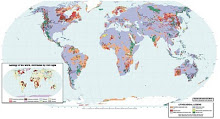Joint FAO-WHO Codex Alimentarius Committee sets new food safety standards
http://www.fao.org/news/story/en/item/238802/icode/
Photo: ©FAO/Giulio Napolitano
Rice for sale at a vendor's stall in Cox's Bazar, Bangladesh.
17 July 2014, Geneva - UN food standards body the Codex Alimentarius Commission this week adopted new standards to protect consumer health worldwide, including setting out maximum acceptable levels of lead in infant formula and of arsenic in rice.
Jointly run by the UN Food and Agriculture Organization (FAO) and the World Health Organization (WHO), the Codex Alimentarius Commission sets international food safety and quality standards to promote safer and more nutritious food for consumers worldwide. Codex standards serve in many cases as a basis for national legislation, and provide the food safety benchmarks for international food trade.
The annual meeting this week was attended by representatives from 170 countries and the European Union, as well as 30 international governmental and non-governmental organizations.
Lead in infant formula
The Codex Alimentarius Commission adopted a recommendation that no more than 0.01 mg per kg of lead should be permitted in infant formula as consumed.
Infants and young children are particularly vulnerable to the toxic effects of lead. They can suffer profound and permanent adverse health effects, particularly affecting the development of the brain and nervous system, which can diminish their ability to learn.
Lead occurs in the environment and trace amounts can end up in the ingredients that are used in the production of infant formula.
Levels of lead in infant formula can be controlled by sourcing raw materials from areas where lead is less present.
Arsenic in rice
For the first time, Codex has adopted a maximum level for arsenic in rice of 0.2 mg/kg.
Long-term exposure to arsenic can cause cancer and skin lesions. It has also been associated with developmental effects, heart disease, diabetes, and damage the nervous system and brain.
Arsenic is naturally present at high levels in the groundwater and soil in some parts of the world. The toxic element can enter the food chain when it is absorbed by crops from water and soil.
Rice in particular can take up more arsenic than other crops and as a staple food for millions of people can contribute significantly to arsenic exposure, which is detrimental to human health.
Arsenic contamination in rice is of particular concern in some Asian countries where paddy fields are irrigated with groundwater containing arsenic-rich sediments pumped from shallow tube wells. Improved irrigation and agricultural practices can help reduce arsenic contamination, for example growing crops in raised beds instead of flooded fields.
The Commission also agreed to develop a new code of practice that will help countries comply with the maximum level set and provide producers with good agricultural and manufacturing techniques to prevent and reduce contamination.
Veterinary drugs
Codex recommended that the use of certain veterinary drugs should be restricted in food-producing animals in order to prevent residual amounts of the drugs remaining in meat, milk, eggs or honey.
The eight drugs (chloramphenicol, malachite green, carbadox, furazolidone, nitrofural, chlorpromazine, stilbenes and olaquinadox), including antimicrobials and growth promoters, can potentially have adverse effects on human health and may contribute to the development of drug resistance.
Other measures
Countries also agreed on maximum levels of pesticide residues and additives in foods as well as maximum levels of contaminants, including toxins called fumonisins that are produced by mould growing on maize. Other measures include new safety and quality standards for foods such as raw scallops, passion fruit, durian and okra.
Future work
Countries decided on a range of topics for future development, including establishing standards for black, white and green pepper, cumin, oregano, thyme and garlic, and setting maximum levels for cadmium in chocolate and cocoa-derived products.
The Commission also discussed the need for a Codex standard for ready-to-eat foods for malnourished children, on the proposal from UNICEF, to guarantee the safety and quality of such foods. The Commission decide to follow up on this discussion at its Committee on Nutrition and Foods for Special Dietary Uses.





